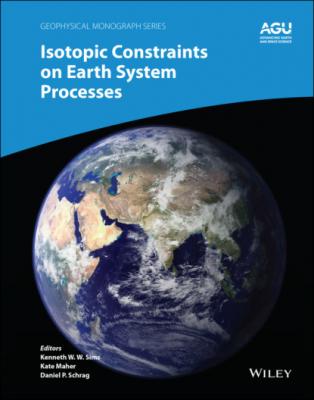Isotopic Constraints on Earth System Processes. Группа авторов
Чтение книги онлайн.
Читать онлайн книгу Isotopic Constraints on Earth System Processes - Группа авторов страница 14
 J., DePaolo, D. J., & Owens, T. L. (1997). Biological control of calcium isotopic abundances in the global calcium cycle. Geochimica et Cosmochimica Acta, 61(12), 2505–2510. https://doi.org/10.1016/S0016‐7037(97)00047‐1
J., DePaolo, D. J., & Owens, T. L. (1997). Biological control of calcium isotopic abundances in the global calcium cycle. Geochimica et Cosmochimica Acta, 61(12), 2505–2510. https://doi.org/10.1016/S0016‐7037(97)00047‐114 Skulan, J., & DePaolo, D. J. (1999). Calcium isotope fractionation between soft and mineralized tissues as a monitor of calcium use in vertebrates. Proceedings of the National Academy of Sciences, 96(24), 13709–13713. https://doi.org/10.1073/pnas.96.24.13709
ABOUT THE COMPANION WEBSITE
This book is accompanied by a companion website:
www.wiley.com\go\sims\isotopic_constraints
This website includes:
Supplementary data for chapters 2 and 3.
DEDICATION
Education isn’t filling a vessel, it is lighting a fire
—W. B. Yeats
Donald J. DePaolo commenced his scientific pursuits during a period when rapid technological advances in analytical mass spectrometry spawned an era of isotopic exploration and discovery, cementing the field of isotope geochemistry as a cornerstone discipline within the geosciences.
For his Ph.D. thesis at Caltech, under the supervision of Gerald Wasserberg, Don measured neodymium isotopes in volcanic rocks, combining the data with a model of crustal formation to define Earth’s mantle structure. It was simple, powerful, and changed the way we think about the structure of the Earth.
From those early days, it was clear that Don had great potential, but few could have predicted the extraordinary trajectory his career would follow, first at UCLA until 1988, and then at UC Berkeley. Over more than 40 years, Don combined careful and rigorous measurements with even greater scientific intuition to make contributions that span dozens of fields. From the crustal evolution of the Earth to reactive transport in groundwater, Don courageously explored new questions and challenged old orthodoxies. Whether in oceanography, glaciology, petrology, mineralogy, or sedimentology, Don aspired for his students and post‐docs to also think critically and clearly about every aspect of the Earth system.
Those of us who were fortunate enough to study under Don, either at UC Berkeley or UCLA, were keenly aware of Don’s fascination with simple models of the Earth at all scales – from models of the crust and mantle to models of ocean chemistry and biogeochemical cycles, and from sediments and pore waters and their mutual interaction to nucleation and growth kinetics of individual calcite crystals. Don pushed all of us to tackle complicated questions using simple tools and clever measurements, reminding us that there was almost no aspect of Earth science that could not benefit from fresh scrutiny.
In his seventieth year, this monograph honors the contributions Don has made as one of the foremost thinkers in the geological sciences. Don’s eclectic scientific interests have not only inspired future generations of scholars but also promoted a new way of attacking the mysteries of the Earth system. We all call ourselves isotope geochemists – but Don expanded the definition of what that means to touch nearly every corner of Earth science and explore the full range of geologic time. Many of us would hardly recognize each other’s work at conferences, but we all share a common background and a common approach cultivated by Don, which is now being passed on to successive generations.
For all of us students, Don has inspired and transformed our lives. Through Don, we learned to think more critically and to find value in quiet contemplation. His unwavering vision of his own scientific career helped us to define our own paths. His unconcealable enthusiasm for a problem well‐posed taught us that science is both important and fun. But perhaps most importantly, through Don’s belief in each of us, we learned to believe in ourselves. And it is for that gift that we will be forever appreciative.
Kenneth W. W. Sims, Kate Maher, and Daniel P. Schrag
1 High‐Temperature Kinetic Isotope Fractionation of Silicate Materials
Frank M. Richter
Department of the Geophysical Sciences, The University of Chicago, Chicago, Illinois, USA
ABSTRACT
Laboratory experiments were used to document kinetic isotope fractionation by mass transport in high‐temperature silicate materials. Large kinetic isotope fractionations were found in experiments in which basalt and rhyolite were juxtaposed and annealed in a piston cylinder assembly, and in experiments where the piston cylinder assembly was displaced from the furnace hot spot so that mass transport was also driven by differences in temperature (i.e., Soret diffusion). Another set of laboratory experiments showed, somewhat surprisingly, that diffusion in silicate minerals can be more effective at fractionating isotopes than diffusion in silicate melts. Isotope fractionations by diffusion in minerals are especially important in that they provide a new way of determining the degree to which diffusion was responsible for all, some, or none of the zoning of minerals from natural settings. Evaporation of silicate materials was an important process in the protoplanetary nebula. This motivated vacuum evaporation experiments that quantified the isotope fractionation associated with the amount of a parent element volatilized, allowing one to interpret the isotopic fractionation of early solar system materials in terms of mass loss by evaporation. A closing section gives some thoughts regarding future directions for research on high‐temperature kinetic isotope.
1.1. INTRODUCTION
It has long been known from the kinetic theory of gases that the relative mobility of isotopes in a gas depends on their mass. In the limit of a rarefied gas with isotopes of mass mi and mj the ratio of their diffusion coefficients is given by Di/Dj = (mj/mi)0.5. In the case of a trace gas diffusing in a gas of molecular mass M the ratio of the isotope diffusion coefficients depends on the inverse square root of their reduced mass so that Di/Dj = ( μ j/ μ i)0.5 where